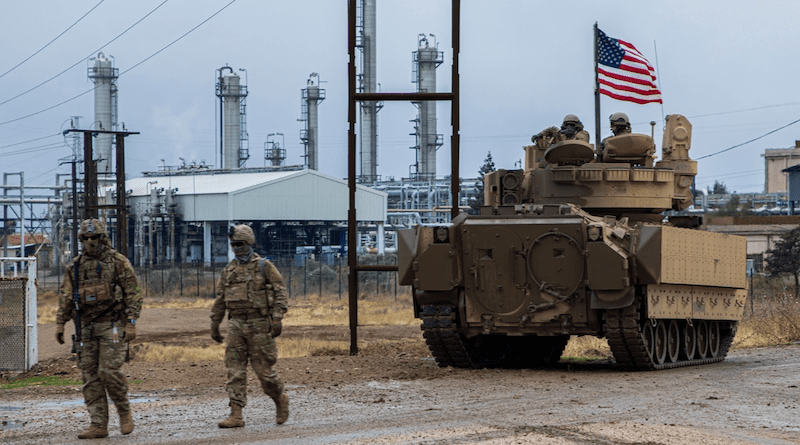US Forces Facing Unprecedented Challenges In Syria – OpEd
By Arab News
By Ghassan Ibrahim*
Militias in northeastern Syria have declared their readiness to confront the US military there. Saraya Al-Khorasani, a terrorist militia, has announced a campaign against the “American occupation” in areas where it is also present in northeastern Syria.
Saraya Al-Khorasani has opened the door to volunteers and attracted hundreds of young men from the region into their ranks by luring them with money and taking advantage of the poverty and deprivation experienced by most Syrians. This militia group specializes in drones, having used them in Iraq to attack US bases and the Green Zone in central Baghdad, demonstrating the extent of its combat experience and its potential to threaten US forces in Syria.
The number of contracted Saraya Al-Khorasani fighters in Syria is estimated to be about 3,500. It works extensively with pro-Iranian militias, including Lebanon’s Hezbollah, making its call for escalation against US forces even more severe and dangerous.
Local Syrian activists have confirmed that the Iraqi-led Saraya Al-Khorasani militia, backed by the Islamic Revolutionary Guard Corps, has set up several new headquarters at Al-Hasakah security square in northeastern Syria.
Before this militia’s calls to resist the American presence, there were several military confrontations between Iranian militias and US forces. Pro-Iranian militants recently attacked US military bases in Syria using drones. The Pentagon has confirmed that US intelligence considers the drones to be of “Iranian origin.”
Since US President Joe Biden took office in 2021, Iranian-linked armed groups have carried out 83 missile and drone attacks against US forces in the region. The US military has responded several times, launching several airstrikes in Syria against Iran-allied groups.
Following one of the American counterattacks, the militias pledged: “The resistance groups reserve the right to respond to the American attack and will respond in kind.” The Iranian Foreign Ministry also condemned the US attacks, accusing American forces of targeting “civilian sites.”
It seems evident that attacks by extremist militias on American bases will not stop and perhaps the American response will be limited to self-defense and nothing else. Statements made by Biden, who warned Iran that the US would take decisive steps to protect Americans, seem to confirm this approach.
However, the challenges facing US forces are not limited to the Iranian side. Turkiye and its militias express dissatisfaction with US forces for other reasons, such as their military support for the Kurdish-majority Syrian Democratic Forces.
In addition to Iran and Turkiye, opposition-affiliated Syrians are dissatisfied with the failure of US forces and the Washington administration to play a fundamental mediating role that could lead to a political solution in Syria.
In this environment, which for many reasons is hostile to the American role, will the administration of President Biden wake up and activate its political function and build its forces in Syria? Or will it continue to act in the same way until it reaches a stage of despair and finally withdraws, as happened in Iraq and Afghanistan?
The calls made by the Saraya Al-Khorasani militia, despite its relatively small size, cannot be ignored. It is an indicator that conveys powerful messages of hostile rhetoric that spreads extremism and uses it against US forces.
Currently, the US Army only has about 900 soldiers in Syria, mainly in the east of the country, alongside US contractors, who number no more than 1,000. The US military presence in Syria was aimed at preventing the emergence of extremist factions, whether from Daesh or the Iranian militias, but what is happening is that these militias have begun to expand and even threaten the US military without a necessary response.
These unfavorable indicators are no secret to the US military and the White House, nor do they surprise them. The US approach to the Syrian crisis remains unchanged, even though the results are not fruitful. There is no indication that a change in how the US deals with the Syrian crisis is on the horizon.
Will the extremist militias push for the withdrawal of the US military from Syria or will their hostile approach force the US to increase its military presence on the ground?
If US forces fail to achieve stability and peace in Syria through a political solution consistent with UN resolutions, while confronting and eliminating extremist groups, their presence in Syria could become a magnet for extremist militias hostile to the US. In such circumstances, the presence of US forces may be counterproductive.
Will the outcome of the US mission in Syria be more positive than those in Iraq or Afghanistan? Given the current situation, this is not very likely.
- Ghassan Ibrahim is a British-Syrian journalist and researcher on Middle East issues, most notably Turkiye, Syria and Iran. He can be reached at www.ghassanibrahim.com.

